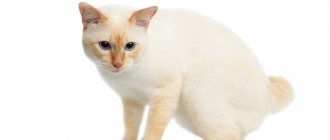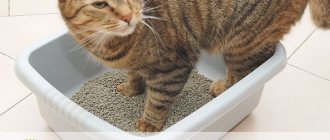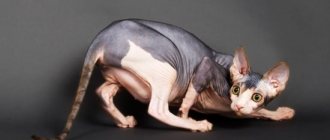Cats are mysterious and very reserved pets. Sometimes it's hard to understand what's on your four-legged friend's mind, and sometimes these pets clearly demonstrate their intentions. However, no matter how cats hide their feelings, an attentive owner can read the pet’s mood. You just need to learn to understand what emotions they experience and how they express them.
How cats sense our emotions
When a cat is alone with a stranger, it remains indifferent or becomes defensive. Nobody thinks about it. It is already clear to everyone that the animal instinctively defends itself. Cats behave completely differently with their owners and their family members. They can rub against your legs and jump on your lap, but they don’t always do this. How does a cat choose the right moment? How does she understand that she is not welcome?
The answer is quite simple. The cat's brain is developed enough to understand our facial expressions, gestures and analyze them. This does not mean that they are capable of empathy. But it is quite obvious that the animal learns to determine the mood of its owner while living together. Subsequently, cats compare the presence or absence of a smile on a person’s face in order to choose their own line of behavior. It has been noticed that cats are much more willing to go into the arms of a smiling person. At this moment, the deep facial muscles are relaxed, there is no internal tension, and cats understand this! Over the years, the smartest cats begin to subtly grasp even the essence of the owner’s gestures. It is clear that the origins of the “sensitivity” of cats go back to the era of their living in the wild. It was the adaptive skill that enabled the species to survive in the primitive period.
Anger
Irritability can quickly turn into anger if the animal is not left alone. Increased negative emotions are indicated by:
- tail moving with a large amplitude from side to side;
- ears pressed to the head;
- point-blank gaze;
- front paw raised for protection;
- arching of the back;
- hiss;
- angry guttural sounds similar to howling.
Do people react to sadness?
Cats are considered to be great healers. The frequency of a cat's purring is 24 Hz, which is quite enough to balance the energy background of diseased human organs. The fact is that the cat perfectly senses the frequency of vibration from unhealthy cells and tries to align them. That is why cats lie on the sick organs of their owners and sleep with them during illness.
The nature of understanding the owner's deep emotional state is of the same nature. For us, sadness often comes after a severe stressful situation. At this moment, the human body vibrates in a completely different way, which the cat reads well. With a cute purr and a soft massage with his paws, he tries to normalize the energy state of his beloved owner.
Fear
Fear is one of the most powerful reactions, since it is generated by the instinct of self-preservation and is associated with a powerful hormonal release in the body. This feeling makes one literally turn to stone on the spot, and the whole cat’s face turns out to be the personification of the saying: “Rhinestone has big eyes.”
Externally, fear is expressed:
- increased muscle tone;
- stiffness of movements;
- head pulled into shoulders;
- rounded eyes, widely dilated pupils;
- ears down;
- with its tail between its legs (read the article on how to understand a cat by its tail).
A frightened cat is silent or makes abrupt, muffled sounds.
How to determine a cat's mood? Watch her tail!
"I'm upset".
If your pet curls its tail under its fluffy butt, it means that it is very sad.
Perhaps this is temporary anxiety now, which may later develop into depression. Reassure your pet and let him know that everything is okay and he is not alone.
Closer to the floor
“I feel guilty.”
If you periodically scold your pet for minor pranks, then pay attention that he will most likely move his tail closer to the floor.
This is a completely normal reaction. Soon he will forget that he was scolded. If you notice this behavior out of nowhere, this may be a signal that the cat is sick. It's better to consult a veterinarian.
Long waves
“What is there, what is there? I'm interested!"
Long “tail” waves often signal that the pet is very interested in knowing what will happen next. Maybe he's looking at someone? Or is he planning something? In any case, this is a positive reaction and there is nothing wrong with it.
Short waves
“I feel uncomfortable.”
This movement of the tail is similar to when a person begins to shake his leg. Either he is nervous or he is thinking hard about something.
Your cat seems to be feeling out of place.
Wipers
“I feel confident.”
If you notice that your pet is moving its paws and its tail is moving in time with it, it means that it feels confident.
Your cat is on his territory, and here he is the King!
Shake
“Go away, old woman, I’m very angry.”
Erratic and rapid movements of the tail indicate that your furry is not in the best mood.
Give him personal space, try not to hug him yet.
Focused Wave
“I'm trying to concentrate.”
Is the tail pointing upward, and its tip making random movements in its own rhythm?
Your pet is lost in thought and trying to focus.
Tail to the side
If your cat is crouched and her tail is “walking” somewhere to the side back and forth, it means she is thoughtful.
It's difficult to understand what a cat is thinking. Perhaps she's contemplating her next move? Or can’t decide what to do first—eat or sleep?
Sonya
"I'm tired".
Very often, cats wag their tail while sleeping, especially after a hard day.
Some find a similar projection in human behavior. Have you noticed that you occasionally startle when falling asleep? This occurs when you are very tired. And cats, in turn, move their tails.
Kalachik
"I'm scared…"
If you pick up a cat and its tail moves towards its body, it means it is feeling excited.
The stomach is a very sensitive place, so cats instinctively try to protect it with their tail. Change the position in which you hold your pet. This way he will calm down faster.
Clock pendulum
“I'm annoyed.”
This behavior indicates that the pet is tired of being in your hands. “It’s time to let me go.”
Source: Natsumi Inoue
Do cats have a sense of humor?
This question is more difficult to answer. Cats may have a sense of humor, but they probably won't find your favorite joke funny. However, when something moves unexpectedly or a toy does something they haven't seen before, cats may seem surprised.
Some cats will even look like they are laughing and try to repeat what amused them.
© shutterstock
It's hard to tell whether this reaction is a manifestation of humor, which is difficult to read and appreciate, or the curiosity that cats have. Chances are, most of the time your cat does something, they are interested in learning more about it, don't quite understand it, or it satisfies some of their instincts.
Playful mood
Kittens play at any age, stretching their muscles and satisfying the “beast in themselves,” but for growing kittens, games are a way to explore the world.
Sometimes cat fun can be too violent, fueled by the hunting instinct and ending with torn curtains or torn upholstery of a new sofa. Wanting to play, the cat takes a typical pose, which is characterized by:
- gaze focused on potential “prey”;
- forward-pointing ears;
- twitching tail tip;
- moving around the apartment in quick leaps;
- sudden attacks from shelters as an element of “hunting” for a broom, a vacuum cleaner brush or the owner’s feet;
- capturing “prey” with all four paws and teeth.
Scientists have discovered who understands cat emotions
The emotions of cats are difficult to understand, but some people are able to surprisingly accurately interpret the expressions of cat faces, Canadian experts from the University of Guelph have found. They talked about this in an article in Animal Welfare
.
Although cats are no less popular as pets than dogs, they have been studied much less well, the authors of the work write. The entire understanding of cat emotions comes down to such manifestations as hissing, raising fur, pressing ears and other signs of aggression. People cannot determine the emotional state of a cat by its meowing, and cannot understand from its facial expressions whether it is in pain or not. However, research has shown that some people are better at recognizing cat emotions than others, so scientists decided to look into this issue in more detail.
“The ability to read animal expressions is critical to their well-being.
We've found that some people are very good at recognizing cats' emotions. This shows that these skills can be taught to more people,” says Professor Lee Neal, lead author of the study.
Until now, the only research that has looked at emotion in cats' faces has been a study of pain expressions.
“Our study is the first to look at assessing a wider range of negative emotional states in animals, including fear and frustration, as well as positive emotional states,” adds Professor Georgia Mason, co-author.
More than 6,300 people from 85 countries participated in the study. 93% of them had owned cats at some point in their adulthood, and 80% were living at home at the time of the study. They had to watch 20 short online cat videos from a collection of 40 videos collected mostly from YouTube and fill out online questionnaires.
close
100%
Universities Federation for Animal Welfare
“We have proven that the Internet and cats are a powerful combination,
- researchers joke. “YouTube has proven to be a rich source of cat videos, and more than 6,000 participants completed our online survey in just ten days.”
The cats in the video experienced either positive emotional states (such as when they were petted or given treats) or negative emotional states (such as when they were experiencing health problems or were in situations that caused them to retreat or run for their lives). Each video focused on the cat's face. None of the cats showed fearful expressions such as bared fangs or flattened ears, as these features are already widely known.
Participants had to answer whether the cat was experiencing positive emotions, negative emotions, or whether they found it difficult to answer.
For most participants, the test was difficult. The average score was 12 out of 20—slightly above chance.
But 13% of participants showed very good results, scoring 15 points or more. More often they were women and veterinarians. Young people also performed the task better.
“The fact that women performed better overall than men is consistent with previous research that has shown that women are better at reading nonverbal expressions of emotion in both humans and dogs,” says Mason.
However, love for cats in itself did not contribute to obtaining higher scores.
The fact that some people can read a cat's emotions shows that others can be taught to do the same, the researchers note.
“This is important because it can help strengthen the bond between owners and cats and thus improve the care and well-being of cats,” says Neal.
Previously, Russian veterinarians said
about what diseases domestic cats most often suffer from.
It turned out that animals in Moscow suffer most from obesity, urolithiasis, as well as allergies and dermatitis, which are caused by the pet’s poor diet.
The most common infectious diseases were calcivirosis and panleukopenia. Maine Coon, Sphynx and Bengal cats are most often brought to see a veterinarian.
Experts noted that it is important to carefully monitor the diet of any pet, as well as vaccinate the animal in a timely manner.
Disappointment
Sometimes cats can become bored, resentful and upset. Gray emotions such as disappointment, sadness and despondency are clearly illustrated by “body language”:
- a faded, absent look;
- ears turned to the sides;
- hunched posture;
- reluctance to play and move actively;
- tail down.
An increase in such signs in combination with disturbances in natural functions, loss of appetite and elevated body temperature indicates a serious illness of the animal and requires the intervention of a veterinary specialist.
Do they understand our gestures?
However, this does not mean that cats are capable of showing empathy. They simply learned to associate their owner's smile with a reward. However, even if cats don't really understand human emotions, they can understand the nuances of our gestures. It also suggests something more fundamental: they are interested in us.
People wonder if cats really understand us and pay attention to their owners. Research by scientists shows that they cannot be completely indifferent.
Perhaps the intelligence of cats is so difficult to detect because their reactions to us are so ambiguous. While purring and rubbing are obviously positive actions, it has also been found that when cats are happy, their body, ears and tail move in certain ways.
Why did Pushkin consider envy a good feeling and did not condemn it, but encouraged it?
Experts have proven that deceivers are easy to mislead
A little butter and the taste is completely different. Bright vegetable side dish
In contrast, scientists have known for several years that dogs react differently to happy and angry people. Their reactions are more obvious. A 2011 study found that dogs will actively avoid an angry person, in addition to changing their body language.











